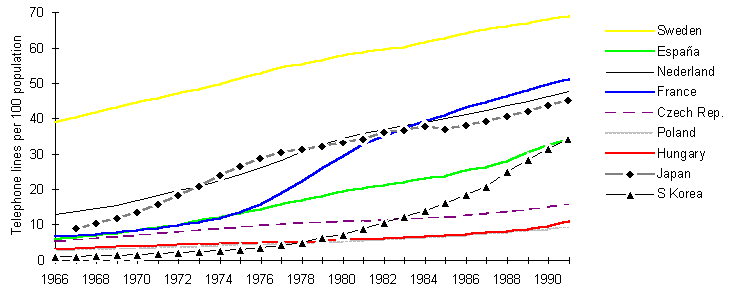
Source: UIT
Following the implementation of an extensive programme of modernisation, France has caught up with or is ahead of most other countries in Europe, at least in most technical considerations. It has a highly sophisticated and fully digital Public Switched Telephone Network, an extensive packet switching network (Transpac) and has implemented Integrated Services Digital Network (Numéris).
In one important respect telecommunications in France is different from the rest of the world. It is the only country with a mass residential market in value-added services. The Télétel system, better known as Minitel (the name of the terminals) reaches over five million French residential and commercial telephone subscribers. A significant number of new services were developed using Minitel either to enhance an existing business service or to create completely new businesses.
Minitel has proved to be French in an almost exclusive way, a true expression of the French nationalistic Complexe Astérix . The technical standard used is French. The equipment is manufactured by French suppliers. Neither the system nor the services have proved to be readily exportable or transferrable. By the mid-1990s, the rest of the world was catching up, as the Internet grew at a tremendous speed.
The rise of French Minitel was far from inevitable. Endeavours to promote and develop equivalent videotex systems in the UK, USA, Canada, Japan and Germany failed for a variety of reasons. Comparisons with these countries make it possible to show how this uniquely French success was achieved and to identify its characteristics.
Today, the Minitel system is exposed to competition within the European Union's single internal market in value-added services. It is also being challenged by new generations of technology, based on Integrated Services Digital Network (ISDN) and Asymmetric Digital Subscriber Loop (ADSL), which are much more technically sophisticated and have the potential to carry more innovative services. The global market for Internet access is now growing in ways which have allowed it to overtake Minitel, elsewhere, if not yet in France. A political challenge to Minitel from the Cour des Comptes [1989], the national auditors, accused France Télécom of creating an artificial market for Minitel-based services and attacked it for wasting public money.
In this case study, the developments which have shaped and continue to shape the market for services using videotex are considered. There is an examination of how firms have responded or might respond to the challenges and opportunities. It also seeks to identify lessons for developers of valueadded services in France and other countries. Insofar as it is possible and judicious, there is a consideration of the future development of videotex.
In videotex, a screen and keyboard are connected via a 'black box' of electronics to a telephone line. The need to transmit digital data over an analogue line usually restricts data transmission rates to 1200 bits per second coming from the database and only 75 bps going from the consumer back to the server. It allows a user to have access to databases containing 'pages' of information represented on the screen in text and crude graphics. At the time, these speeds were adequate and close to the limits of what could be achieved.
The vision of the inventors of videotex was that by combining telephone lines and television sets an enormous market could easily be created. The penetration levels of both systems were so high that a vast number of homes were already equipped with both and all that had to be done was to link the two together. The resulting system would provide access to massive quantities of information for large numbers of people. It was seen not only as being good for the UK, but to have considerable export potential. For commercial, political and technical reasons these views were to be disabused.
The idea of the Prestel service was enthusiastically received both by the senior management of the Post Office and by the UK Government. In encouraging the development and adoption of Prestel, the main objectives were:
The UK Government under Labour (1974-1979) was in favour of intervention to support the use of information technology as, initially, was the Conservative Government which succeeded it. In particular, Kenneth Baker, the Minister for Information Technology (1981-1984) drummed up support for the use of IT, through activities such as IT'82, the year of information technology.
Videotex was to be taken up in other countries for similar reasons. It was to be perceived very much as a national pursuit.
Additional competition came from computers. Videotex was conceived and launched before the IBM PC, which radically changed perceptions of computing. At the time the only competition was from games computers. There was little competition for information supply in the domestic market, though rather more in the commercial sector where some specialists were working, for example, Reuters and Dialog.
A related service has been developed called teletext. In this the data are transmitted within a conventional television signal, obviating the need for the telephone line. The electronics for teletext were built into the television sets. In the UK these are known as Oracle and Ceefax. The uptake of teletext was much higher than videotex. The incremental cost for the adapter was relatively low and it quickly became an accepted feature of top of the range models from which it spread downwards. In the UK, 15% of television sets are sold with a teletext facility. Oracle claims to have over 1,200 pages of information, including 200 pages of advertisements targeted at over four million television sets suitably equipped. Over four million viewers 'watch' Oracle each day, giving a weekly view of over six million viewers. Commercial services are paid for by advertising. [Keynote, 1988]
Successful videotex markets can be seen as a combination of issues from both supply and demand sides, though mainly the former. The following sections explore these issues, considering the lessons learned. [PIIC, 1988]
To be successful on the supplyside, videotex initiatives have required the collaboration of network owners (usually the post telephone and telegraph monopoly PTT), IT equipment manufacturers and information providers. If the videotex system was to be built to a national standard then the national IT supply industry had to be able to meet most of the demand. This implied the existence of the technological capability to design and build the systems. Perhaps more importantly, it required the commercial capacity to exploit the market opportunity.
A key decision has been whether to use an adaptor for television sets or to build dedicated terminals. For the domestic market the former was thought to be better, while for the commercial market a dedicated terminal has been felt essential.
To achieve a low unit cost it was necessary for manufacturers to have available a 'chipset', a number of specifically designed integrated circuits, which could be installed in decoders or terminals. A significant scale of production was required if the chip maker was to recover the development costs. A similar issue arose with ISDN, where a 'chipset' has been vital to reduce the cost of ISDN terminals and add-on cards for workstations. In neither case has the extent of demand been sufficiently clear to determine the final price level of terminals.
In most countries the government or PTT selected the standard for videotex. However, in the USA there was no attempt to set a technical standard. The Federal Communications Commission (FCC) declined to do so on the grounds that the market should choose between the conflicting standards. At no time has a significant volume of consumers been established which would signal this decision, despite the efforts of a number of industries which have tried to enter the videotex market: retailers, publishers, financial services, etc. [Chin, 1985]
The introduction of a new service was always likely to bring out old rivalries between the telecommunications utilities and post offices, television companies and newspapers. These have varied from country to country, depending on the existing power structure.
The approaches used in developing a videotex service have been quite varied. The British chose to create a number of computers spread throughout the UK to which local rate telephone calls could be made. Each computer held a copy of the complete Prestel database. The database was updated regularly using the data communications network. Access to the database was easy and cheap with loading on the backbone digital network kept to a minimum. The problem with this approach was one of creating a menu structure which allowed users easy access to the pages of data. Despite considerable efforts at simplification the hierarchical menu structures were neither easy nor efficient to use.
Information providers require a large market if they are to provide services in a cost effective manner. They need to recover the costs of the time and effort of converting printed material into a computer database and of making that material available in a form suitable for the system. Equally, they must devise a system for accessing the information, a combination of human computer interaction and menu structure.
This has tended to create a vicious circle of participants waiting for the market to develop. Information providers want a population of users willing to buy services. Manufacturers wanted to see sufficient information services for consumers to feel justified in purchasing the equipment. Consumers wanted cheap terminals or adopters and interesting services up and running. Given these factors some measure of coordination has been called for, either through the market or, more frequently, through government intervention.
There were many obstacles to the adoption of videotex in the home. Conventionally, the television set is used only for entertainment. By trying to modify this role, conflict is introduced, often real conflict between members of a family, to which the only easy solution is to buy another television set. Similar problems were encountered with early home computers. The physical and social settings are not conducive to the assimilation of information. In addition, the ergonomics of videotex systems were never very good, finding the information on many systems could be frustrating. Once found, reading a television screen is uncomfortable and not well suited to absorbing text-based information.
Videotex has had to compete with existing and established sources of information. Newspapers and magazines are well established, relatively cheap and widely read.
The fundamental question which remains answered in the negative is 'Do consumers want more information?' It appears that whilst they will buy certain services, they do not want information or are unaware of what they want. Perceptions of the information society were biased by an overintellectualisation, consumers rejected this too serious 'rational' model; the information being offered was worthy but dull. As the French experience was to show, people adopted a 'fun' model, playing silly games, and a more practical model, buying their shopping and checking their bank accounts.
Similar problems were encountered in the market for computers in the home. The choice was perceived as being between silly games or abstruse programming languages. To succeed in a general market sensible applications were and still are required.
In the commercial sector in the UK, the greatest success lay in closed user groups. The best of these is in the travel sector, where the initiative of Sealink was taken up by Thomson [Palmer, 1988] and has led to every travel agent in the country making extensive use of videotex.
High levels of ownership of personal computers can create a potential market of knowledgeable computer users who can be sold relatively cheap 'add-ons' for their computers to allow them to use the service. They also constitute a population from which innovative information providers might come, for example, devising videotex services is a useful application of skills developed in writing computer games.
Organising the supplyside has proved much easier than determining and meeting the needs of consumers. This is particularly worrying given the amount of effort already expended and the requirement to go the same process for ISDN.
In following the British example, of seeing videotex as something national, many countries were to follow in its failure. National factors such as telecommunications regulation, media structures and perceptions of videotex influenced the outcome through political fighting of new and emerging power players.
In Germany the videotex service, Bildschirmtext, was launched in 1983, following limited experiments begun in 1980. A dedicated terminal was chosen because of the strictly defined role of the Deutsche Bundespost. The view taken was that terminals had to be built by private industry and sold to consumers. The intention of the service was to generate network traffic for the Deutsche Bundespost (DBP). Although it has grown steadily (see table), the service ran at an annual deficit of over DM 100 million in the late 1980s. In 1994 it was repackaged and marketed as Datex-J, an Internet access service. [Schneider, 1989]
| 1984 | 1986 | 1988 | Subscribers | 21,329 | 58,365 | 146,929 | Information providers | 3,099 | 3,528 | 3,360 | Pages on system | 521,783 | 589,330 | 666,167 | Number of connections per month | 282,729 | 1,064,825 | 3,153,435 |

Source: UIT
France stands in a respectable position in the European Union ranked list. Its spurt of growth in the early 1980s is particularly noticeable.
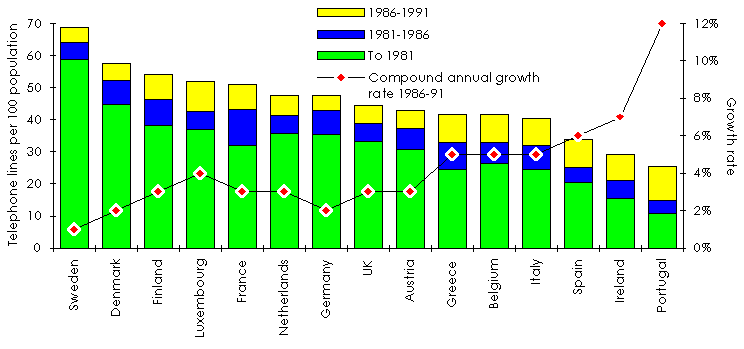
Source: Siemens AG
While the position of France in conventional telephony is good, both by European and global standards, in mobile telephony the picture is very different. France has been slow to develop its market and reluctant to admit competition. As the figure shows, it lags Italy and Ireland.
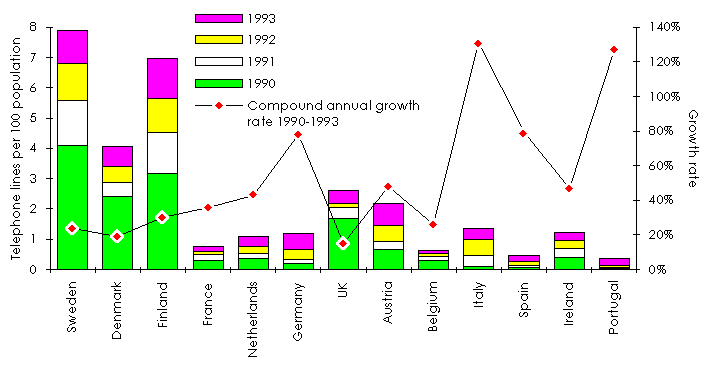
Source: Siemens AG
Thus France in the mid-1990s has a technically sound and ubiquitous network. However, its market has been reformed only slowly and under pressure from the European Commission in Brixelles and foreign regulators. France Telecom remains the dominat supplier.
France Telecom continued to grow in the 1980s and 1990s. However, it did so without the reduction in staff seen in some PTTs and RBOCs. (See figure)
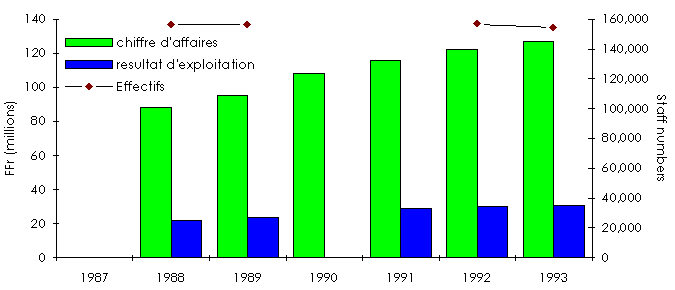
Source: France Télécom
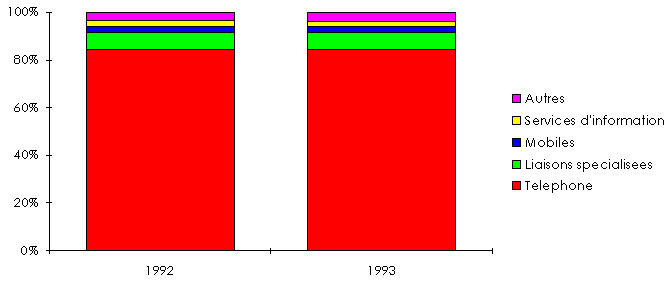
Source: France Télécom
Competition in the French market is growing as the European Union directives take effect. While it is not as competitive as Sweden or the UK and not yet attracting the level of interest of Germany. In addition to the usual international players (BT, AT&T, RBOCs, etc) there are many domestic French companies keen to enter the market, some already have entered it:
At the end of August 1995, the French government through the minister for information technology, Monsieur Francois Fillon, announced changes for France Telecom. Marcel Roulet, the chairman for some years, was to be replaced by Francois Henrot, the chairman of Compagnie Bancaire, a financial holding company. Henrot had worked at France Telecom earlier in his career.
Within days Henrot resigned, before formally taking office. The reason being alleged comments by Fillon to the effect that the organisational reform of France Telecom could be further delayed. He was replaced by Marcel Bon, head of the government's unemployment agency.
Whether as the DGT or as France Télécom, the French PTT was breaking new ground in moving into videotex. The DGT knew little about broadcasting or about collaboration with information providers and almost nothing about consumers. What it did have was the ambition and the desire to emulate other great technological feats, such as Concorde and the Train à Grande Vitesse (TGV).
The French government and PTT chose to develop videotex primarily because of its hightech image combined with the potential of the service to reach such a large part of the population. Videotex promised to help overcome the image of France as being backward in telecommunications. Moreover, it would support the growth of the public data network, Transpac. Undaunted by the failure of Prestel in the domestic market, the French chose to target that market.
The objective of conquering the world market has not been achieved. In spite of some successes, the computing and telecommunications industries are far from being able to rely on French electronics suppliers. Few peripheral devices have been developed or sold and many components of the Minitel terminal have had to be imported. [Salomon, 1986]
An electronic telephone directory service was also being developed. Initially it was tested separately in 1983 in St Malo, then expanded to the departement of IlleetVilaine in Brittany. Brittany has been a common testing ground for French telecommunications.
An important decision was not to follow the British route of using television adaptors, but to choose a dedicated terminal, the Minitel. France Télécom also chose to focus on the residential market, rejecting the failure of Prestel, in the belief that they could push through to success. Technologically, the system was second generation videotex.
The T3V experiment led to a fullscale plan for the introduction of Minitels into the rest of France. The aim was to provide free terminals to all telephone subscribers. It was to be paid for by the substitution of the existing paper telephone directories with access to a database containing details of all French telephone subscribers. Thus exchanging a local paperbased and, inevitably, out-of-date service for a national uptodate and online service. To keep down unit costs, the scale of purchases was to be very large, aiming at 500 francs per terminal.
The scope of the initial plan was breathtaking aiming at over 20 million Minitels by 1990. This was intended to solve the historical problems of slow uptake of communications in France.
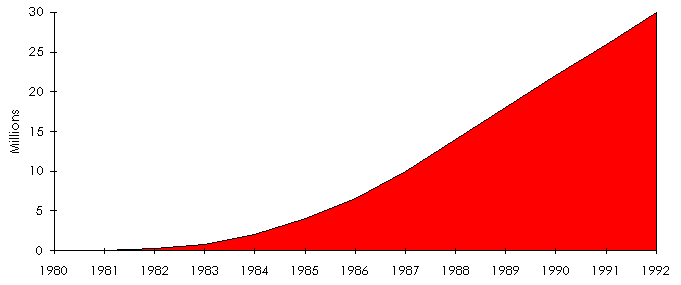
Source: France Télécom
However, after the election of President Mitterrand and the Socialist Party in 1981 the compulsory replacement of the printed directory was abandoned for political reasons; compulsion was felt to be excessive. Thereafter, only volunteers were given Minitels, causing a major loss in momentum to the plan. Nonetheless, over 5,000,000 Minitels have been distributed and over 5,000,000 hours of connect time are used each month.
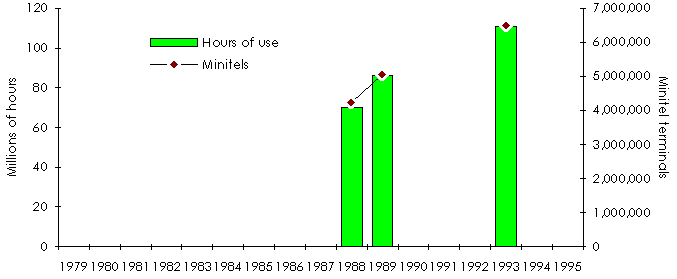
Source: France Telecom
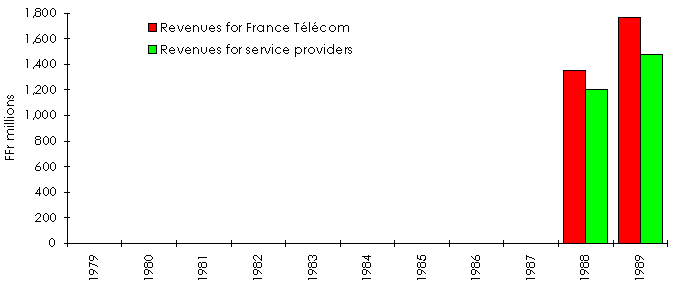
Source: France Telecom
It was only a small minority who used more than four services (see Figure 1). There are a small proportion of heavy users, amongst whom are an even smaller minority of addicts who generate enormous bills. Given the nature of the services they use, they will be quite different from, for example, the schizoid addicted programmers described by Shotton [1990].

Source: Arnal et Jouet, 1989

Source: Arnal et Jouet, 1989
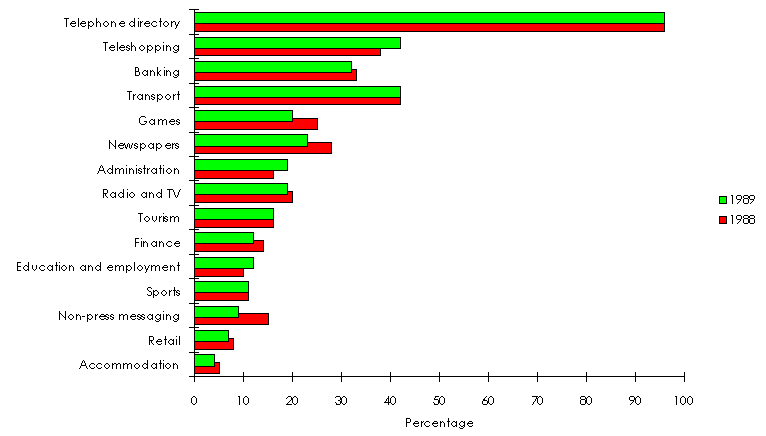
Source: France Télécom, 1989.
If one is to identify a single feature which encouraged the creation of new services on Minitel it was the kiosk tariffs. This allowed potential new service providers to startup without an established market. The kiosk tariff system operated by France Télécom collects a charge from the telephone subscriber for the services used, based on a call to one of a number of special telephone numbers; France Télécom separately records the number of connect minutes to each service. The tariff system is now highly sophisticated, allowing a variety of divisions in cost between users and providers, ranging from free to nine francs per minute.
Thus the service provider does not need a complicated accounting system, nor does it require prepayment. In effect, France Télécom acts as an intermediary between customer and supplier. Behind the kiosk tariffs is the distance independent tariff of Transpac, making the location of the computer providing the service irrelevant.
The real success of the kiosk system lay in allowing service providers on Minitel to differentiate themselves. A subscriber dials 36.15 then keys in the brand name of a product or service:
For example, 36.15 Coke is aimed at promoting the image and products of CocaCola through the provision of games and news concerning sport and music, it also offers a reservation system for concert tickets. Thus it is easy to associate a Minitel service with existing or new products and services.
In other countries, the necessity of prepayment or the use of credit cards has presented considerable obstacle to the use of videotex services. Similarly, paying by page was found to be a discouragement, it seemed to be an 'unnatural' way to charge, it is better to charge by time. Adverts appear to be treated by consumers as intrusive.
Messagerie Conviviale & Messagerie Rose
Minitel has been seen as the birth of a new cultural industry sitting beside film, radio and television. It is claimed to be different because the network is used for broadcasting, communication and transactions. It does not appear to fit with traditional models of editing used for the written or spoken word, neither are the approaches of film or television appropriate. Through the messaging services, the public can communicate with each other; often concealed by a pseudonym. [Pajon, 1989]
Whilst there may be some merit in the argument that Minitel is a new medium, it cannot be held to be true. Minitel is similar to too many other services for the distinction to be valid. The messagerie services are similar to conventional electronic mail and bulletin boards. The game services are closely related to the thriving market in computer games. Home banking and teleshopping are extensions of information systems which are otherwise unremarkable and closely linked to EPoS and EFTPoS. The telephone directory is simple information retrieval.
Minitel is unique in scale, scope and the degree of integration, but it is not unique in function.
A wide range of business services can be found on Minitel. These include links to clients, suppliers and within firms providing new levels of connectivity within and between organisations.
The applications in the business sector reflect similar applications to those found elsewhere in the world. Where the French applications are different lies in the low cost entry into telecommunicationsbased services. Thus the French firm Drogerie Bordelaise did not have to face the same costs as the American firm Baxter Healthcare to establish telecommunications links with their customers [Monnoyer and Philipe, 1989]. The French company was able to adopt a standard terminal, the Minitel, which the client might already possess or could obtain very cheaply. There was no need to lease lines, to develop access methods to the public switched data networks or to acquire telecommunications management skills. Minitel was already there providing these services.
The Minitel infrastructure significantly lowered entry barriers into telecommunicationbased services representing a form of subsidy from France Télécom (effectively the taxpayer) to businesses. The Minitel network can be seen as pumppriming investment by France Télécom to generate network revenues on a system with high fixed costs. The validity of this depends on the government making a return on the investment or obtaining some other national goal.
Le Guide du Minitel, rather grandly, likened the pseudonym to the use of masks at the Venice Carnival's Ball Masqué. In many ways it is similar to the use of Citizens' Band radio in the USA, providing a high degree of personal expression.
The messaging services developed in a thematic way around sport, politics, pastimes and, of course, sex. There rapidly developed a market in sexually explicit services of a quite lurid character known as messagerie rose under names such as Cum, Eros and SM. The nature of the services is shown in the advertisements. These were placed in magazines and in some cases some in large size on bus stops in Paris.
In economic terms messagerie rose, through its notoriety, added to public awareness of Minitel and so attracted considerable revenues to France Télécom. Press comment added to the advertising.
One of the saving graces of these services was that Minitel is a form of sexe sans risque; you cannot contract AIDS from a Minitel.
It is argued by some French observers that users of these services are playing harmless social and erotic games, not really meaning the things they write [ULB, 1987].
The original idea of introducing messaging services was that people could develop an understanding and experience of systems for the new information age. What emerged was a 'problem' closer to the chatlines (0898 numbers) in the UK, the telephone sex services in the USA (1-900 numbers) or Berlusconi's commercial television services in Italy.
Yet the public are evidently willing to pay for such services. It may be that some people consider them 'immoral'. Some may engage in the hypocrisy of using the services and denouncing them as immoral.
It was argued that telecommunications helped to break down the old socio-political order in Eastern Europe. If the same thing is now to happen to Western Europe, then it is difficult to complain. It is not being done pour épater les bourgeois, but because there is a market, a part of which is undoubtedly bourgeois. The question of public hypocrisy arises.
Whilst there may be some merit in the argument that Minitel is a new medium, it cannot be held to be true. Minitel is similar to too many other services for the distinction to be valid. The messagerie services are similar to conventional electronic mail and bulletin boards. The game services are closely related to the thriving market in computer games. Home banking and teleshopping are extensions of information systems which are otherwise unremarkable and closely linked to EPoS and EFTPoS. The telephone directory is simple information retrieval.
Minitel is unique in scale, scope and the degree of integration, but it is not unique in function.
There was also a case of the father of a family who who killed three gay men he arranged to meet through the use of Minitel services.
Minitel services are used for other sexual activities, including bestiality, paedophilia, prostitution and the distribution of amateur video cassettes.
There is a powerful lobby against the messagerie rose, in the form of FFF: Federation des familiales de France, representing 160,000 families.
As in most countries, France has a general law against incitement to debauchery. However, enforcing this is very difficult, both practically and politically.
Instead, the route chosen was tax. In January 1989 the Government promulgated a tax of thirty per cent on the turnover of certain named services which it designated to be pornographic. This was raised to 50% in 1992. It was estimated to have closed some thirty services by 1992.
On 4th October 1994, the Cour des Comptes reported that the tax was ineffective. In 1992 it raised nothing at all and in 1993 only 194,888.50 FFr. Given the estimated annual turnover of more than 500 milliards of Francs, this indicated an almost total evasion of the tax. It could simply be the result of services giving up or redesigning their product offering to avoid the tax.
Evasion was achieved by mixing services with games, horoscopes, information and so on, creating a service which was not exclusively pornographic. Moreover, one legitimate service could act as a gateway to pornographic services. Where the tax was imposed, cases were invariably contested before a tribunal, making it very expensive to collect.
The Syndicat des Professionnels de la Télématique Conviviale estimate that 5,000 people are employed providing these services and that the turnover is around 500 FFr milliards. The Syndicat constitutes a substantial lobby for the retention of the services.
Such laws and taxes are argued to restrict the development of Minitel and to be in breach of EU Directives.
The gay community opposes moves to restrict access. It sees Minitel as important infrastructure for the community. It is a friendly way for people to come to terms with their sexuality and ultimately to come out.
Complex issues of free speech and of the privacy of personal relationships. The latter is guaranteed in the European Convention on Human Rights.
Very little support for action against Minitel services, only 2% of a Harris poll.
Future issues include video-telephony. Also premium-rate telephone services.
| Savings on printed directory | 147 | Savings on directory enquiries | 272 | Miscellaneous receipts | 122 | Tariffs from traffic | 1,779 | Rental of Minitels | 618 | Total savings | 2,939 | Terminals | 6,144 | Distribution of terminals | 150 | Other equipment | 1,673 | Maintenance | 339 | Total costs | 8,307 | Deficit | FFr 5,367 M |
Note: Calculated in 1987 Francs.
Minitels have a life expectancy of seven to eight years, within which period the Cour des Comptes considered it was impossible to recover the costs using the existing tariff. This life expectancy also implies that a programme of replacement will soon be required.
France Télécom countered that additional, though unspecified, telephone traffic had been generated by the use of the online directory. Minitel was still growing, making estimates of profitability difficult and suggesting the Cour des Comptes underestimated income. Revenues from Transpac had been omitted from the calculations. France Télécom stressed that Minitel was an accepted international success.
Instead of developing Minitel, the Cour des Comptes suggested, that the money would have been better spent on the reduction of business telephone tariffs. This comment reflects the comparatively high telephone and data communications tariffs set by France Télécom.
France Télécom has undoubtedly been far more successful than any other PTT in developing videotex (See Table). Even allowing for a level of nonuse allegedly as high as 40 to 60% it still exceeds comparable countries by a large margin. The Cour des Comptes failed to consider the profits generated by Transpac, neither did it try to quantify the return from the manufacture of Minitel systems. Therefore, in one sense Minitel can be judged a success, even if the shortterm financial basis is less clear.
| Country | Terminals | Services | Population | Terminals per 1000 population |
| France | 4,227,076 | 9,578 | 57,100,100 | 74.03 |
| Germany | 122,069 | 3,379 | 61,180,000 | 2.00 |
| Sweden | 16,700 | n.a. | 8,458,900 | 1.97 |
| Australia | 32,000 | 200 | 16,263,300 | 1.97 |
| Netherlands | 24,945 | 223 | 14,805,000 | 1.68 |
| Austria | 9,084 | 643 | 7,573,000 | 1.20 |
| Finland | 4,414 | 262 | 4,955,000 | 0.89 |
| Norway | 2,092 | 150 | 4,221,538 | 0.50 |
| Ireland | 1,700 | 10 | 3,540,000 | 0.48 |
| Italy | 27,499 | 280 | 57,527,437 | 0.48 |
| Belgium | 4,303 | 100 | 9,876,000 | 0.44 |
| Canada | 4,000 | 50 | 25,795,800 | 0.16 |
| Brazil | 15,188 | 47 | 144,427,586 | 0.11 |
| Spain | 988 | n.a. | 39,217,804 | 0.03 |
[Source: UIT, 1990]
The key question with ISDN concerns the services which consumers would buy; 'putting the S into ISDN'. At present, the evidence is that photovideotex is being used, for example, by estate agents to sell property. Some businesses are beginning to use Group 4 Facsimile, which is a technical upgrading of Group 3 facsimile, of much higher quality.
The Commission of the European Communities has been active in telecommunications in technical developments, through programmes such as RACE and ESPRIT. It has played an important role in the development of the idea of Integrated Broadband Communication (IBC), which will eventually replace ISDN.
A major French experiment has been conducted at Biarritz, to evaluate interactive cable television. As yet, the Government has not chosen to act the findings and the experiment has been played down in recent months. However, interactive cable represents a logical extension of Minitel, with a number of advantages, including an enormous increase of the bandwidth for signalling and potentially very large audiences.
French telecommunications are at least technically comparable with other leading countries and arguably better. (See Table)
| Country | Telephone lines per 100 population | Mobile lines per 100 population |
| France | 45.23 | 2.5 |
| Germany | 45.90 | 2.0 |
| UK | 39.00 | 11.5 |
| Netherlands | 43.67 | 0.3 |
| Belgium | 36.04 | 0.2 |
| Italy | 34.93 | 0.8 |
| Norway | 47.76 | 38.4 |
| Japan | 40.68 | n.a. |
| Canada | 51.20 | n.a. |
| USA | 40.91 | n.a. |
[Source: UIT 1990 & Financial Times 1989]
Where France is clearly lagging is in mobile telephony. France Télécom has been far slower to introduce cellular radio systems than the UK or the Nordic countries.
In the areas of regulation and liberalisation, France has been slow to change. It is unclear whether France has liberalised its telecommunications industry to the extent necessary to be able to face the current round of changes. The European Commission is endeavouring to create a single market in telecommunications, both data communications and value added services. The USbased RBOCs (regional Bell operating companies) and other liberalised telecommunications operators (e.g., Cable and Wireless) are developing global networks and are moving into Europe. Meanwhile, the French postal and telecommunications services are only now being separated.
At a meeting of the Telecommunications Council in December 1989, the European Community decided to create a single market in telecommunications and services. From 1 January 1991 there will be a free market in value added services which will be followed by a free market in data services from 1 January 1993. Greece, Portugal and Spain are to be allowed an extra two years to develop their data services before they would be exposed to competition.
The creation of this market occurs at a time when the RBOCs are beginning to flex their muscles in Europe. From the European perspective a danger lies in creating a market in time for the Americans to take the largest share. We have already seen AT&T acquire the UK firm ISTEL as part of its Global Messaging System. Given the large installed user base of Minitels it would be relatively easy for service providers to move into the French market.
There is little evidence of French providers of VANs striking out beyond France, other than in collaboration with France Télécom in a few small scale joint ventures to provide Minitel service in other countries. Some new traffic is being generated from links to other countries, allowing some consumers to access French Minitel services.
The life of the technologist is continually confounded by the cussedness of the customer, whose unpredictability and disinterest are legendary. Videotex, outside France, failed to convince, partly because technology and not services were being sold.
"Many executives in this infant industry are haunted by the fear that the inventors once again trapped management into investing in something simply because it can be done [Meyer, 1983]."
We may live in the information society but, paradoxically, people do not appear to want information on a personal basis and certainly will not pay the full price for it.
Home banking has been a considerable success, with most banks participating. It was a logical extension of the automation of banking through the development of cash dispensers, treasury management systems, etc. However, evidence from the UK suggests that voice-based systems are a much cheaper and attractive alternative.
Teleshopping has also been successful. It to was a logical extension of automation in the retail sector, part of a growing rationalisation of the distribution of goods. There remains considerable scope for further developments. One very attractive area is comparison shopping, showing tables of prices for the same goods in different stores.
At present we are seeing a massive growth in voicemail, to such an extent that it might overtake electronic mail. This seems to reflect ease of use. It is in clear contrast to the relatively lacklustre performance of X.400.
The key question with ISDN concerns the services which consumers would buy; 'putting the S into ISDN'. At present, the evidence is that photovideotex is being used, for example, by estate agents to sell property. Some businesses are beginning to use Group 4 Facsimile, which is a technical upgrading of Group 3 facsimile, of much higher quality.
The Commission of the European Communities has been active in telecommunications in technical developments, through programmes such as RACE and ESPRIT. It has played an important role in the development of the idea of Integrated Broadband Communication (IBC), which will eventually replace ISDN.
A major French experiment has been conducted at Biarritz, to evaluate interactive cable television. As yet, the Government has not chosen to act the findings and the experiment has been played down in recent months. However, interactive cable represents a logical extension of Minitel, with a number of advantages, including an enormous increase of the bandwidth for signalling and potentially very large audiences.
French telecommunications are at least technically comparable with other leading countries and arguably better. (See Table)
| Country | Teledensity (1988) | Mobile density | France | 45.23 | 2.5 | Germany | 45.90 | 2.0 | UK | 39.00 (1) | 11.5 | Netherlands | 43.67 | 0.3 | Belgium | 36.04 | 0.2 | Italy | 34.93 | 0.8 | Norway | 47.76 | 38.4 | Japan | 40.68 | Canada | 51.20 (2) | USA | 40.91 (3) |
Source: UIT 1990 & Financial Times 1989
Notes:
1 Figure for 1979
2 Figure for 1987
3 Figure for 1982
Where France is clearly lagging is in mobile telephony. France Télécom has been far slower to introduce cellular radio systems than the UK or the Nordic countries.
In the areas of regulation and liberalisation, France has been slow to change. It is unclear whether France has liberalised its telecommunications industry to the extent necessary to be able to face the current round of changes. The European Commission is endeavouring to create a single market in telecommunications, both data communications and value added services. The US-based RBOCs (regional Bell operating companies) and other liberalised telecommunications operators (e.g., Cable and Wireless) are developing global networks and are moving into Europe. Meanwhile, the French postal and telecommunications services are only now being separated.
At a meeting of the Telecommunications Council in December 1989, the European Community decided to create a single market in telecommunications and services. From 1 January 1991 there will be a free market in value added services which will be followed by a free market in data services from 1 January 1993. Greece, Portugal and Spain are to be allowed an extra two years to develop their data services before they would be exposed to competition.
The creation of this market occurs at a time when the RBOCs are beginning to flex their muscles in Europe. From the European perspective a danger lies in creating a market in time for the Americans to take the largest share. We have already seen AT&T acquire the UK firm ISTEL as part of its Global Messaging System. Given the large installed user base of Minitels it would be relatively easy for service providers to move into the French market.
There is little evidence of French providers of VANs striking out beyond France, other than in collaboration with France Télécom in a few small scale joint ventures to provide Minitel service in other countries. Some new traffic is being generated from links to other countries, allowing some consumers to access French Minitel services.
The life of the technologist is continually confounded by the cussedness of the customer, whose unpredictability and disinterest are legendary. Videotex, outside France, failed to convince, partly because technology and not services were being sold.
Many executives in this infant industry are haunted by the fear that the inventors once again trapped management into investing in something simply because it can be done.
[Meyer, 1983]
We may live in the information society but, paradoxically, people do not appear to want information on a personal basis and certainly will not pay the full price for it.
Home banking has been a considerable success, with most banks participating. It was a logical extension of the automation of banking through the development of cash dispensers, treasury management systems, etc. However, evidence from the UK suggests that voice-based systems are a much cheaper and attractive alternative.
Teleshopping has also been successful. It to was a logical extension of automation in the retail sector, part of a growing rationalisation of the distribution of goods. There remains considerable scope for further developments. One very attractive area is comparison shopping, showing tables of prices for the same goods in different stores.
At present we are seeing a massive growth in voicemail, to such an extent that it might overtake electronic mail. This seems to reflect ease of use. It is in clear contrast to the relatively lacklustre performance of X.400.
The other change is the growth of sales of Minitel cards as add-ons for personal computers The appearance of popular access to the Internet provides an alternative platform for service providers. They must decide to build applications for Minitel or for the Internet:
... all of the Teletel editors I know are asking themselves on what platform they will put their service and how they will out their service and how they will change the product.France Télécom offers both Kiosque Micro at 14,4k bps and Télétel Access Numéris at 64k bps. By comparison, Téle´tel Vitesse Rapide (TVR), also known as Minitel 4, operates at only 9.6k bps. This isfar from state-of-the-art, though much faster than the existing 1,2k bps:
Christope Sapet, PDG, Infogrames Entertainement
TVR has arrived a bit late from our point of view and we don't believe that it represents an interest for photos, just text transmission speed.In Kioskque Micro applications run in a Microsoft Windows environment. For service providers it requires considerable work in adding sound and graphics, presenting technical and marketing problems.
Gerard Laroux, Secretaire-Generale, Association Francaise de Telematique (Aftel)
The old Minitel will continue for a while because there are lots of applications that need only that and very few French homes are equiped with PCs and modems. It also remains an inexpensive tool for small companies that don't have the financial means to equip themselves with PCs.The phasing out of the Minitel terminals could take until around 2001.
Ronan Le Moign, Jouve S.A.
Internet service providers are operating in France as in other European countries. For example:
Although successful in many senses, the Minitel case is ambiguous. Clearly, Minitel could not have occurred without governmental action. Equally, the status quo of the early 1990s was artificial and is now being undermined both by the forces of the market and technological change.
Technological obsolescence is always a danger and has now hit Minitel. To sustain the success, a transition must be made to a new generation of technology. However, changes in the boundaries of the market and the changes in the rules of the competitive game have made this impossible on the same terms as before. These changes could not reasonably have been foreseen when Minitel was launched. Minitel, if successful, should have been superceded by an ISDN-based service, presumably a form of photo-videotex. Now it faces being absorbed into Internet access, a market dominated by companies based in the United States of America. In the longer term it will have to adjust to Video-on-Demand services.
As we move into what is termed the 'information economy' services such as Minitel clearly deserve attention, they indicate some of the things we can expect. Innovation in the provision of services will be a key to the development of value added services; which represent an important sector of the information economy.
Clearly providers of value-added services in France have learned many valuable lessons. The question is whether they will attempt and succeed in transferring these to the broader European market. It will not be so easy since the framework of the kiosk tariffs, networks and terminals will not be there. However, the financial rewards will be much greater. The evidence to date is that little development has taken place.
What seems to have been learned is that it is necessary to have mechanisms in place to ensure a functioning market. Although arguably artificial, the Minitel system has shown how such a market can operate. The services which consumers seem to want are diverse, but are certainly not the supply the dreary information. Instead they want to be able to purchase goods, check their bank balances, and identify products and services. Importantly, they want to play games and to communicate with one another. Minitel is much more like an extension of the telephone than a combination of the telephone and television.
The table shows the similarities, but mainly the differences between French and British adoption of videotex.
| United Kingdom | France | Home and office market | Domestic market | Adaptor for television | Dedicated terminal | High quality picture | Medium quality picture | Low penetration rate | High penetration rate | Rapid achievement of critical mass | Rivalry between France Télécom and TdF | Centralised service | Decentralised service | Hierarchical menu | Flat menu structure | Diversity of tariffs | Kiosk tariffs | Pre-subscription | Pay as you view | Recover investment | Pay for costs |
Note: TdF is Télévision de France.
| 1973 | Invention of videotex in UK | 1978 | Report by Nora and Minc | 1978 | Approval of initial Minitel experiment | 1979 | Launch of Prestel service in United Kingdom | 1981 | Télétel Vélizy, Versailles, Val-de-Bièvre (T3V) experiment | 1983 | Telephone directory trial at St Brieuc | 1987 | Initial experiments with Numéris (ISDN) | 1988 | Creation of 36.05 numéro vert (free calls) | 1989 | Report of the Cour des Comptes | 1993 | Introduction of 50% tax on 'pornographic' services | 1994 | France Télécom joined General Magic consortium |
http://www.georgetown.edu/sutherland/minitel/print.html